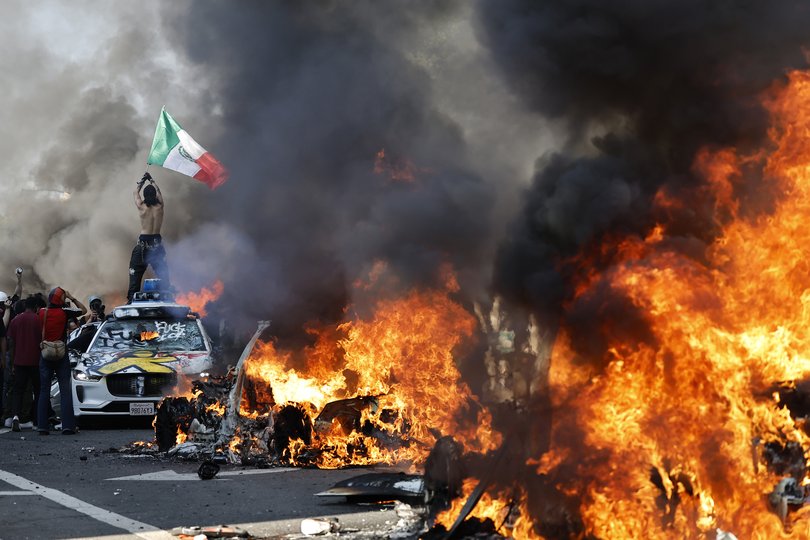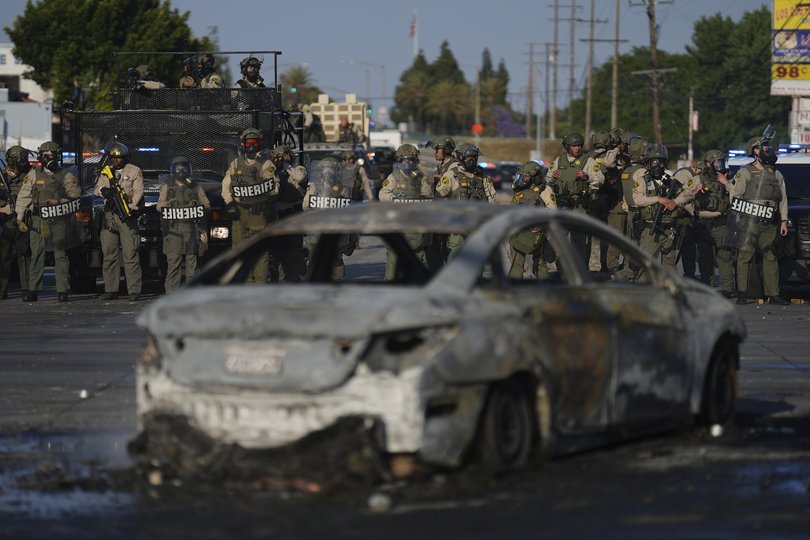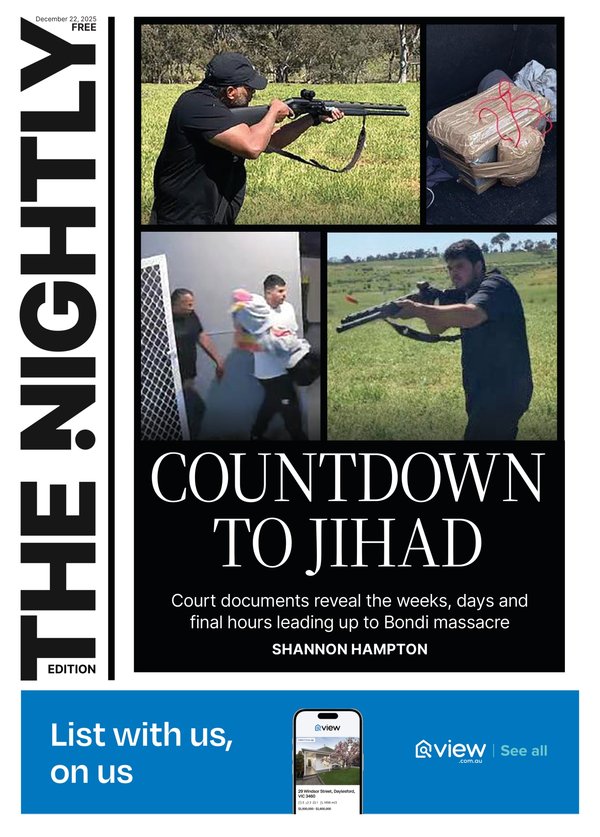What to know after weekend of LA protests over immigration raids
Hundreds of National Guard troops arrived in Los Angeles on Sunday after President Donald Trump mobilised them to quell anti-ICE protests, as clashes between demonstrators and law enforcement entered a third day.
Protesters gathered in LA’s downtown, as well as in the nearby cities of Compton and Paramount over the weekend, in response to a series of deportation raids in areas of the city with large immigrant populations.
Trump said the National Guard was needed because of “numerous incidents of violence and disorder,” but Gov. Gavin Newsom said the deployment was escalatory and that the situation was already under control. Newsom said he would challenge the order with a lawsuit on Monday.
Sign up to The Nightly's newsletters.
Get the first look at the digital newspaper, curated daily stories and breaking headlines delivered to your inbox.
By continuing you agree to our Terms and Privacy Policy.Here’s what to know.
Where are the latest protests and how did law enforcement respond?
After an uneasy morning of relative quiet, demonstrators clashed with law enforcement officers around downtown Los Angeles on Sunday afternoon and into the evening.
Hundreds marched more than a mile from Mariachi Plaza to the area around Edward R. Roybal Federal Building, which houses an immigration detention center and has transformed into the city’s most prominent protest site.

Although most appeared peaceful, some demonstrators threw objects at police officers in riot gear positioned around the detention center. More than two dozen National Guard members also appeared to be there as well on Sunday, at one stage donning masks.
Police used tear gas and shot less-lethal pellets into the crowd, prompting demonstrators to scatter before many returned. On the adjacent 101 freeway, California Highway Patrol officers used tear gas canisters to move hundreds of protesters off the road - where traffic was brought to a standstill in the midafternoon.
According to the Los Angeles Police Department, members of the crowd threw concrete and other objects at its officers and attempted to breach a skirmish line. The department said it detained two motorcyclists whom it accused of injuring two officers after attempting to breach the skirmish line near the federal building.
By evening, the Los Angeles Police Department said demonstrators had splintered into several different areas of downtown, including around the Civic Center neighborhood. Police issued a dispersal order for the area. Photographs showed a vehicle alight and marked with protest graffiti.
On Sunday night, the LAPD said at least 10 protesters were arrested that day, in addition to the 29 arrested the day before. California Highway Patrol officers made at least 17 arrests in protests on the freeway.
What sparked the protests?
The protests began after federal officials conducted immigration raids in Los Angeles and surrounding communities, resulting in more than 100 arrests. Mexican President Claudia Sheinbaum said Saturday that 35 Mexican nationals were among those detained.
At a Los Angeles Home Depot near downtown, where one of ICE’s raids unfolded Friday, workers who witnessed the operation said officers began handcuffing anyone they could grab as more than a hundred men and women standing in the parking lot began to run.
As word of the raids spread, demonstrators began to gather in downtown Los Angeles, Paramount and Compton.

The Trump administration denounced the protesters as “rioters,” accused them of attacking ICE officers and other federal agents, and said that the response of state and local officials had been inadequate.
Newsom insisted that state and local law enforcement had the situation under control and urged demonstrators to stay calm.
What powers did Trump invoke to deploy the National Guard?
On Saturday evening, Trump invoked a law aimed at quelling serious domestic unrest to mobilize 2,000 members of the California National Guard to intervene. He said in his executive order that the unrest was prohibiting the execution of immigration enforcement and therefore met the definition of a rebellion.
About 300 troops had arrived by Sunday to protect federal property and personnel, according to U.S. Northern Command.
It’s the first time in about 60 years that a president has federalised the National Guard without that state’s consent. According to legal experts, it’s also the first time the statute has been invoked without the Insurrection Act.
“That is completely unprecedented under any legal authority,” Elizabeth Goitein, senior director of the Liberty and National Security Program at the Brennan Center for Justice, told The Washington Post. “The use of the military to quell civil unrest is supposed to be an absolute last resort.”
On Sunday, Trump vowed to “have troops everywhere” in response to the demonstrations and threatened a forceful response against even nonviolent actions. He said he was not yet prepared to invoke the Insurrection Act to quell the demonstrations but that he was watching the situation closely.
What have California officials said?
Newsom has fiercely criticised Trump’s deployment of the National Guard and said that California intended to challenge its legality in a lawsuit Monday.
In an MSNBC broadcast, he said Sunday that Trump’s mobilisation of the National Guard was “unconstitutional” without his consent.
“Democracy is in the balance. I mean, you’re seeing these authoritarian tendencies that are being acted out by this administration, and we’re a case in point as it relates to nationalizing, federalizing, the National Guard, threatening now to put in Marines,” he said, referencing a statement by Defense Secretary Pete Hegseth.
Addressing Angelenos, Newsom urged protesters to stay peaceful. “Those who assault law enforcement or cause property damage will risk arrest,” he wrote on X.

Los Angeles Mayor LA Mayor Karen Bass told Angelenos that she supported their right to protest peacefully, blaming the unrest on the Trump administration.
“What we’re seeing in Los Angeles is chaos provoked by the administration,” she said, reminding the city’s inhabitants that they have the right to express their feelings under the First Amendment - but to do so nonviolently.
She said: “I call on all Angelenos to continue expressing your right, your anger, your outrage, but to do it peacefully.”
Kelly Kasulis Cho contributed to this report.
© 2025 , The Washington Post
